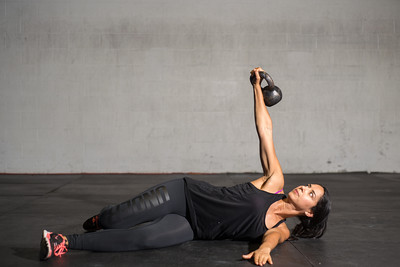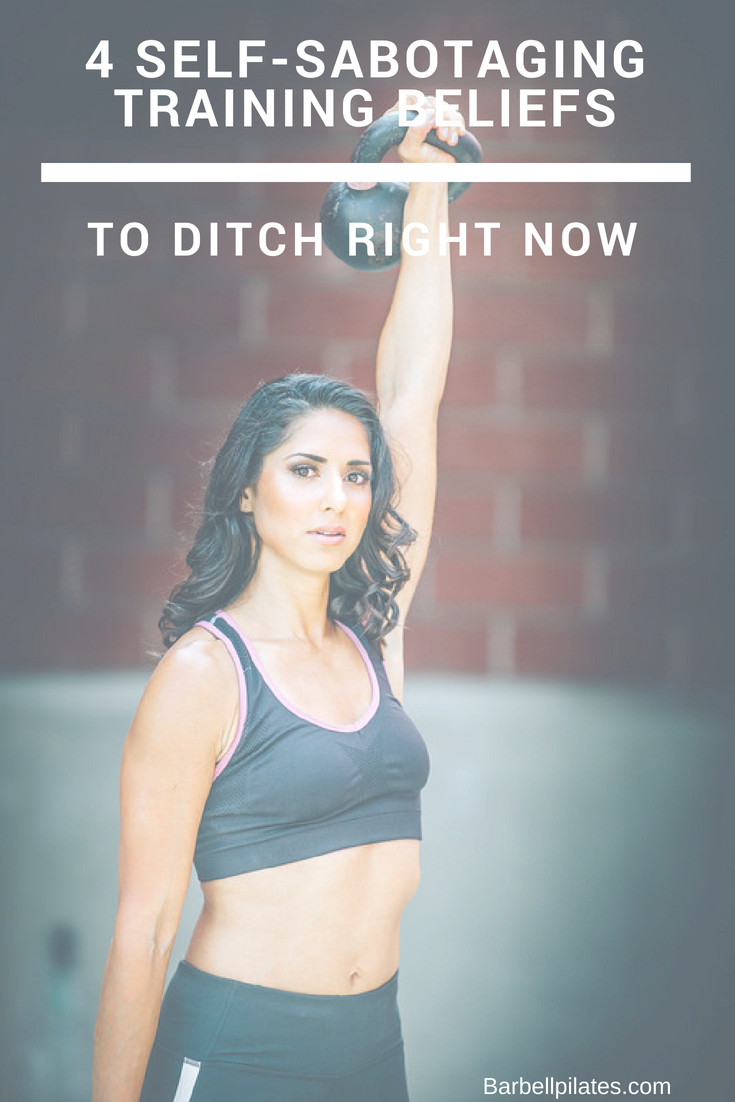Nothing inspires me more than seeing women get after it in the gym. The ladies inside my private Facebook group are tackling their goals while balancing work and motherhood; my female clients are hitting PRs and learning new skills like front squats and chin-ups.
I love it.
No doubt women have made some major strides regarding strength training over the years, but there’s still so much work to be done if we want all women to feel confident and fearless with a barbell in their hands. It takes a lot of self-awareness and practice to ditch these old beliefs and empower ourselves with thoughts that enable us to be more, not less of ourselves.
Here are four common, outdated beliefs that may be holding you back from achieving the fitness results you’re after.
Belief #1: You have to spot train to look good
This old way of thinking is the #1 killer of fitness results for women. While there may be specific areas that deserve a bit more attention than others, our bodies don’t function spot by spot.
If you look at how a bodybuilder trains you’ll see that she/he spends a significant amount of time developing every area of the body, not just one. You want to shrink your thighs? Hit exercises that target the entire leg musculature instead of gluing yourself to the adductor machine.
If you want sculpted arms and shoulders, put down the light dumbbells, quit lifting weights on a stationary bike, and start incorporating deadlifts, chin-ups, and push-ups into your workouts. You’ll get a better training stimulus, work more muscles, and still work those arms.
The lesson: If spot treating hasn’t worked for you in the last 5-10 years, then maybe it’s time to do something different. Learn how to lift. Strength train your whole body not just the itty bitty parts you don’t like.
Belief #2: Treating cardio like it’s the only fat loss tool around
A Boston-based strength coach recently posted something along the lines of “Strength training IS fat loss,” and it had me fist pumping the air in agreement.
The thing is, cardiovascular training is crucial for overall health and wellbeing, but it’s not the Holy Grail of fitness. In fact, spending all of your time on cardio will sabotage your fitness results unless your goal is actually to improve some aspect of your cardiovascular health or endurance.
If your goal is fat loss, your game-changing habits will revolve around strength training and nutrition, not going for a run 5x a week.
Also, strength training can give you a cardio-esque stimulus depending on how you use it. For example, my latest training program Strong Body Fitness Guide provides one day a week of either finishers, complex chains, or metcon workouts that are cardiovascular focused while lifting weights. Does it work for fat loss? You betcha! Do you need to add another hour on the treadmill for fat loss to occur? Absolutely not.
Lesson: Fat loss is attainable with strength training. Stop pretending like you need to squeeze in more cardio for it to be effective (unless you really want to squeeze it in).

Belief #3: Associating soreness or high intensity with effectiveness
A client of mine recently said she loves being sore because she feels like her workouts are working. I admit, I love a little soreness after a workout, but I know better than to use that to determine a program’s overall effectiveness.
Soreness, or feeling like you have to puke in the middle of a session, are not good indicators of how effective a workout is.
Going hard every workout isn’t necessary. In fact, it’s more detrimental to your overall success in the long-run. If your coach programs a few workouts that feel easy-ish, you either went too light with the weights or it was intentional.
Not every workout will feel super challenging all the time. In fact, you may even find yourself with a little bit of energy at the end. That’s perfectly normal. If you’re hitting compound exercises, cleaning up technique, and doing the right accessory work, you don’t need to beat yourself every single time you walk into the gym.
The takeaway: You should be able to walk out of a training session feeling energized, not completely drained. Stop associating soreness with effectiveness because it’s not the same thing.
Belief #4: You think you can do it all
If staying active is your jam, then you likely want to do all the things — yoga, pilates, CrossFit, powerlifting, running, etc.
I get it. It’s fun to mix it up, and every one of these modalities have something specific and wonderful to offer. However, if you have a performance or physique goal you want to achieve you have to give up the activities that don’t align with that goal, at least for a little while.
When I trained for half marathons, strength training took a back seat for 12-16 weeks. Yet once running season ended, I could pick up lifting again while scaling back the milage.
Same goes with powerlifting. I’ve taken over a year off from training the major lifts so I had more liberty to do weekly beach runs, Pilates, and general strength training. But as I gear up for competition season, I’m less likely to “mix it up” and instead focus on what will prepare me for my meet.
Your workouts should support your goals, and that sometimes means temporarily giving something up. Stop complaining about it. You will survive not going to aerial yoga or whatever it is for a few months. Focus on the goal and train for that.
How to stop self-sabotage
With those old belief systems out of the way, I want to leave you with a few tips to end your self-sabotage and start training better for your goals.
- Focus on one thing – Stop trying to be great at everything and start getting really incredible at one thing. If you want to look good for your wedding, that’s your focus. If you want to improve your performance in a certain sport, focus on the things that will lead you there. Stop tacking on extra sports, activities, goals that only interfere with your ultimate goal.
- Outsource your programming – Unless you’re a trainer or enjoy educating yourself on different training protocols and exercise science, hire someone to handle your pro
gramming. You wouldn’t perform a root canal on yourself just because you saw a YouTube video on it, would you? It shouldn’t be any different with your training. The Strong Body Fitness Guide is an easy to follow 12-week training program that takes you through dumbbell workouts to barbells while making you strong, more confident, and energized. If you’re on the hunt for a done-for-you program that you can trust, this is an excellent option. - Do exercises that you suck at – The reason I don’t do my own programming is because I know I’ll just focus on exercises I like and am good at instead of the ones I need. And usually, the things you’re terrible at are what you need most. Feel wobbly doing a 1-leg RDL? Balance is probably something you need to work on. Would you rather eat dog poop than do conditioning? You’re likely in need of a few interval sessions. Stop doing only the things you like. Start training your weaknesses too.
- Stay open to new ideas – It’s unlikely that you’ll train the same way 10 years from now. By staying open to new coaches, new cues, or just different training methods, you can learn a lot about yourself and improve your fitness results.
Want a training program you can trust? Grab the Strong Body Fitness Guide program before the price goes up!




Comments 2
I agree with every one of those myths, Nice work Trish.
Thanks man! Always happy to provide info that resonates…even better when people agree with me lol 😉